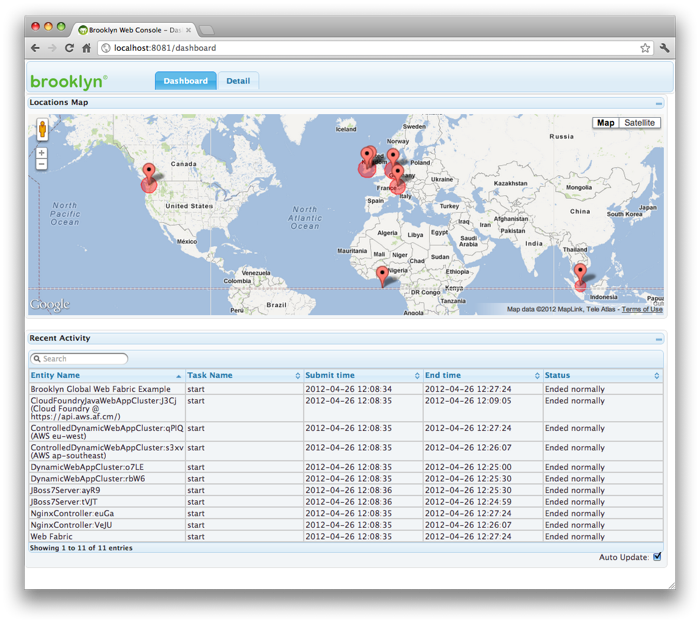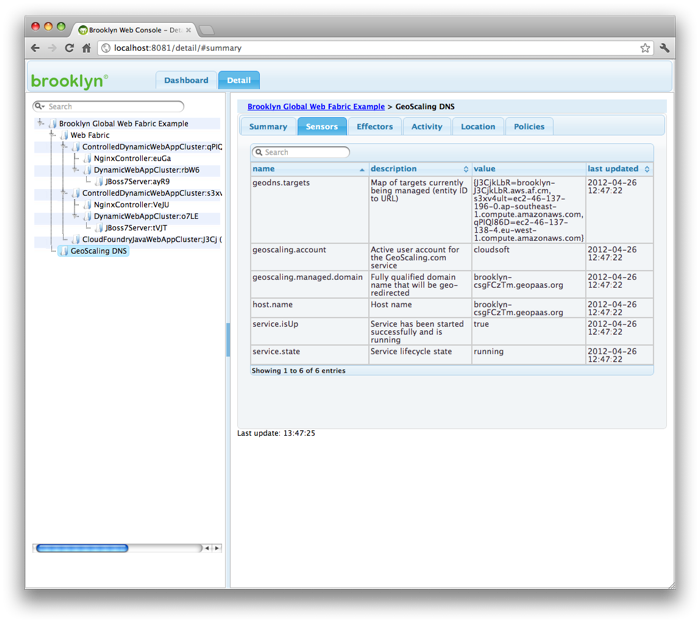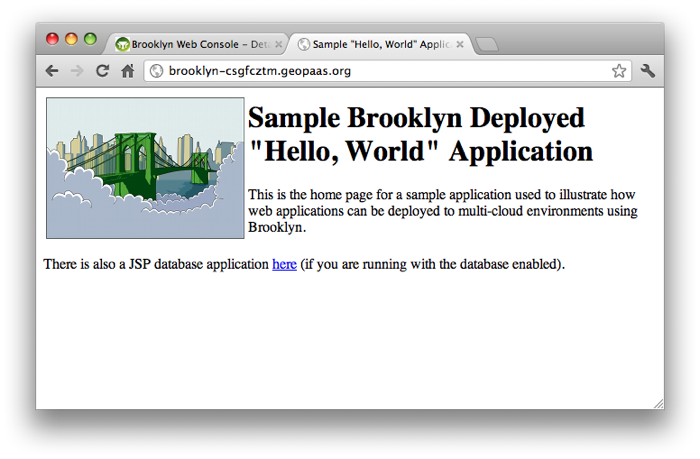Global Web Fabric
This example shows how to build a multi-site web application fabric with DNS configured on the front-end to combine the sites, routing users to the location closest to them.
It can combine with the Simple Web Cluster example or the Portable Cloud Foundry example, but does not assume knowledge of either of these.
Before You Begin
To use the examples, you'll need curl, git, java (1.6+), and maven (v3) installed.
Installing Brooklyn
(If you followed the Getting Started instructions, you can skip to Installing the Examples.)
Grab a copy of the Brooklyn distribution and set up BROOKLYN_HOME:
% curl -LO http://repo1.maven.org/maven2/io/brooklyn/brooklyn-dist/0.5.0/brooklyn-dist-0.5.0-dist.tar.gz
% tar xvzf brooklyn-dist-0.5.0-dist.tar.gz
% export BROOKLYN_HOME=$(pwd)/brooklyn-0.5.0/
Installing the Examples
Grab a copy of the brooklyn-examples source code and build with Maven:
% git clone https://github.com/brooklyncentral/brooklyn-examples.git
% cd brooklyn-examples
% git checkout 0.5.0
% mvn clean install
For more information on ways to download Brooklyn please see the download page. For more information on the Brooklyn CLI and launching apps, please visit this section of the user guide.
Now, go to this particular example's directory:
% cd global-web-fabric
The CLI needs to know where to find your compiled examples. You can set this up by exporting
the BROOKLYN_CLASSPATH environment variable in the following way:
% export BROOKLYN_CLASSPATH=$(pwd)/target/classes
The project global-web-fabric contains the code used
in this example under src/main/java.
Setting Up Geographic DNS
This example uses geoscaling.com to provide free geographic-dependent DNS services. This will forward a domain name of your choice to various IPs depending on a script, e.g. computing the nearest IP based on latitude and longitude of the requester and the targets. Brooklyn will automatically generate and update this script, but you do need to create and configure a Geoscaling account:
- Create the free account here.
- Click the link in the email you receive.
- Enter the domain name you wish to use into geoscaling (see below).
The simplest domain name to choose is something unique under geopaas.org, e.g. yourname.geopaas.org,
which we have already configured for Geoscaling to manage.
If you are using your own domain name,
set its nameservers as advised by geoscaling (e.g. ns{1,2,3,4}.geoscaling.com).
Next we need to supply this information to Brooklyn at runtime.
The simplest way is to create or add the following fields to ~/.brooklyn/brooklyn.properties:
brooklyn.geoscaling.username=yourname
brooklyn.geoscaling.password=s3cr3t
brooklyn.geoscaling.primaryDomain=yourname.geopaas.org
Replace the values of these fields as appropriate, of course! You can, if you prefer, supply (or override) these values in your Brooklyn application.
Setting Up the Locations Database
In order to generate the "closest-IP" script,
Brooklyn needs a way to find out the latitude and longitude of the
servers you are using.
The simplest way to do this is do download the free GeoCityLite binary flatfile
from MaxMind,
unpack it, and copy it to ~/.brooklyn/MaxMind-GeoLiteCity.dat.
This will be picked up automatically if it is installed.
You can instead specify to use an online lookup service, such as
utrace.de by specifying
-Dbrooklyn.location.geo.HostGeoLookup=brooklyn.location.geo.UtraceHostGeoLookup;
but note this has a cap of 100 per day.
This information is also used to display locations on the map in the Brooklyn dashboard. Note however that these free services are not 100% accurate; they are handy for dev/test but in a production system you may wish to specify the geographical information manually in your application, or purchase a commercial locations-database subscription.
The Code
Now let's start writing our application. The heavy lifting will be done by off-the-shelf Brooklyn classes:
DynamicFabricwill create the entity specified byfactoryin each location it is givenGeoscalingDnsServicemonitors children of a specified entity (theDynamicFabric) and adds them as DNS targets for the region they are in
First, however, let's create the Java class -- call it GlobalWebFabricExample.
This will extend the Brooklyn AbstractApplication:
package brooklyn.demo;
import static com.google.common.base.Preconditions.checkNotNull;
import brooklyn.entity.basic.AbstractApplication;
public class GlobalWebFabricExample extends AbstractApplication {
@Override
public void init() {
// TODO create our app!
}
}
The Fabric
The DynamicFabric by default has no knowledge of what it will build,
other than the factory it is given to create an entity in each region.
We'll use the class ElasticJavaWebAppService.Factory which creates
an elastic Java Web App service,
such as the ControlledDynamicWebAppCluster used in the
Simple Web Cluster example, if deploying to VMs,
or perhaps a CloudFoundryJavaWebAppCluster if deploying to a Cloud Foundry location
(see brooklyn-cloudfoundry repo).
DynamicFabric webFabric = addChild(EntitySpecs.spec(DynamicFabric.class)
.displayName("Web Fabric")
.configure(DynamicFabric.FACTORY, new ElasticJavaWebAppService.Factory())
.configure(ElasticJavaWebAppService.ROOT_WAR, WAR_PATH));
Here we have specified the WAR to use with configure(ElasticJavaWebAppService.ROOT_WAR, WAR_PATH).
The war configuration used in the previous example is only available on web-aware entities;
configuration specified with a ConfigKey can be done on any entity,
and is inherited at runtime, so this provides a useful way to specify the WAR to use
even though the web-aware entities are only constructed at runtime.
Stitching the Fabric together with DNS
To stitch these together seamlessly, another entity will run a policy
which collects the public-facing IP address of each cluster created by the fabric,
as it comes online, by watching for SERVICE_UP sensors.
First, however, let's make sure any load-balancer proxies (e.g. nginx) in these clusters
are listening on port 80:
DynamicFabric webFabric = addChild(EntitySpecs.spec(DynamicFabric.class)
.displayName("Web Fabric")
.configure(DynamicFabric.FACTORY, new ElasticJavaWebAppService.Factory())
.configure(ElasticJavaWebAppService.ROOT_WAR, WAR_PATH)
.configure(AbstractController.PROXY_HTTP_PORT, PortRanges.fromInteger(80)));
Let's now define the Geoscaling entity which does the stitching.
We need to supply the username, password, and primaryDomainName for Geoscaling;
we'll take this from the brooklyn.properties file mentioned above.
We'll also specify a smartSubdomainName, to use Geoscaling's facility for
lightweight sub-domains to prevent DNS caching and multiple instances of our application
from confusing us -- e.g. brooklyn-1234.yourname.geopaas.org.
StringConfigMap config = getManagementContext().getConfig();
GeoscalingDnsService geoDns = addChild(EntitySpecs.spec(GeoscalingDnsService.class)
.displayName("GeoScaling DNS")
.configure("username", checkNotNull(config.getFirst("brooklyn.geoscaling.username"), "username"))
.configure("password", checkNotNull(config.getFirst("brooklyn.geoscaling.password"), "password"))
.configure("primaryDomainName", checkNotNull(config.getFirst("brooklyn.geoscaling.primaryDomain"), "primaryDomain"))
.configure("smartSubdomainName", "brooklyn"));
Lastly we need to tell this instance what entity it should monitor for children to include as targets:
geoDns.setTargetEntityProvider(webFabric);
Cloud Foundry and other PaaS Targets
At this point our core application is ready, and can be deployed to AWS or another VM cloud.
This may take between 15 and 30 minutes to run,
mainly spent downloading software
(unless of course you specify a pre-configured imageId which contains the software).
A quicker alternative is to deploy to a Java Web App platform-as-a-service such as Cloud Foundry. A major advantage here is that they can provision very quickly, in a matter of seconds. Code for this can be found in the brooklyn-cloudfoundry repo, along with an example global-web-fabric app.
Imports
Your imports should look as follows:
import static com.google.common.base.Preconditions.checkNotNull;
import org.slf4j.Logger;
import org.slf4j.LoggerFactory;
import brooklyn.config.StringConfigMap;
import brooklyn.entity.basic.AbstractApplication;
import brooklyn.entity.basic.Attributes;
import brooklyn.entity.dns.geoscaling.GeoscalingDnsService;
import brooklyn.entity.group.DynamicFabric;
import brooklyn.entity.proxy.AbstractController;
import brooklyn.entity.proxying.BasicEntitySpec;
import brooklyn.entity.webapp.ElasticJavaWebAppService;
import brooklyn.location.basic.PortRanges;
Use of main method (optional)
In this example, we will use the brooklyn CLI launcher. However, it is possible to write your own main method.
The following static constants are assumed (most of these as in the Simple Web Cluster example and others):
WAR_PATH, pointing to the webapp to deploy (a default supplied as part of the Brooklyn examples is used here)DEFAULT_LOCATIONS, containing a string spec of the locations to deploy to if none are supplied on the command-line; for this examplelocalhostwill frequently not work unless Geoscaling can see it (i.e. it has a public IP and appropriate firewall settings)
The code (which can safely be omitted) is as follows:
import brooklyn.launcher.BrooklynLauncher;
import brooklyn.util.CommandLineUtil;
import com.google.common.base.Joiner;
import com.google.common.collect.ImmutableList;
import com.google.common.collect.Lists;
// class definition, and rest of class goes here...
public static final Logger log = LoggerFactory.getLogger(GlobalWebFabricExample.class);
// points to the webapp to deploy (a default supplied as part of the Brooklyn examples is used here)
public static final String WAR_PATH = "classpath://hello-world-webapp.war";
// locations to deploy to if none are supplied on the command-line; for this example `localhost` will
// frequently not work unless Geoscaling can see it (i.e. it has a public IP and appropriate firewall settings)
static final List<String> DEFAULT_LOCATIONS = ImmutableList.of(
"aws-ec2:eu-west-1",
"aws-ec2:ap-southeast-1",
"aws-ec2:us-west-1" );
public static void main(String[] argv) {
List<String> args = Lists.newArrayList(argv);
String port = CommandLineUtil.getCommandLineOption(args, "--port", "8081+");
String locations = CommandLineUtil.getCommandLineOption(args, "--locations", Joiner.on(",").join(DEFAULT_LOCATIONS));
BrooklynLauncher launcher = BrooklynLauncher.newInstance()
.application(EntitySpecs.appSpec(GlobalWebFabricExample.class).displayName("Brooklyn Global Web Fabric Example"))
.webconsolePort(port)
.locations(Arrays.asList(locations))
.start();
Entities.dumpInfo(app);
}
Running the Example
Now let's run this example. You will need to specify increased heap size and memory limits, as well as the appropriate classpath.
export BROOKLYN_CLASSPATH=/path/to/your/project/target/classes
${BROOKLYN_HOME}/bin/brooklyn launch --app brooklyn.demo.GlobalWebFabricExample \
--location jclouds:aws-ec2:eu-west-1,jclouds:aws-ec2:ap-southeast-1,jclouds:aws-ec2:us-west-1
The management web console will start, followed by the web-app services in the locations specified creating the VM's as needed. Let's look at the management web console, on port 8081 (default credentials are admin/password):
This shows the targets (e.g. Ireland (AWS eu-west-1), Singapore (AWS ap-southeast-1)) as well as a few other places (wrong locations picked up for some AWS IP's!). This also shows the progress of the most recent tasks.
Navigating to the "applications" tab, we can view sensors, invoke effectors, control policies,
and track activity,
for instance if a cluster is slow to start and you want to find out what is going on
(you'll find additional information in the brooklyn.log file).
Let's drill down on the Geoscaling DNS entity's sensors:
Here we see it has chosen brooklyn-csgFCzTM.geopaas.org as the geo-load-balanced domain name.
(Yours will be under yourname.geopaas.org, unless you chose a different domain earlier.)
We can also see the hosts it is forwarding to, one for each cluster, corresponding to the
children of the Web Fabric (propagated from the nginx hostnames, in the case of the ControlledDynamicWebAppCluster instances).
Checking the Web App
Once Geoscaling reports at least one target, you should be able to access it on the geo-load-balanced domain name:
Under the covers you are being routed to one of the clusters that has been deployed -- whichever one is closest to you. (Due to DNS caching, at your machine or your ISP, clusters which come online after your first lookup will not be picked up until TTL expires, typically 10m, although often more if DNS services don't respect TTL.)
Checking DNS Information
Let's find out exactly where we were routed:
% dig brooklyn-csgFCzTm.geopaas.org
; <<>> DiG 9.4.3-P3 <<>> brooklyn-csgFCzTm.geopaas.org
;; QUESTION SECTION:
;brooklyn-csgFCzTm.geopaas.org. IN A
;; ANSWER SECTION:
brooklyn-csgFCzTm.geopaas.org. 120 IN CNAME ec2-46-137-138-4.eu-west-1.compute.amazonaws.com.
ec2-46-137-138-4.eu-west-1.compute.amazonaws.com. 215 IN A 46.137.138.4
This was run from Scotland so it seems a sensible choice.
(Some portions of the output from dig have been removed for readability.)
We can get more information by looking at the TXT records:
% dig +trace @ns1.geoscaling.com TXT brooklyn-csgFCzTm.geopaas.org
; <<>> DiG 9.4.3-P3 <<>> +trace @ns1.geoscaling.com TXT brooklyn-csgFCzTm.geopaas.org
...
geopaas.org. 86400 IN NS ns1.geoscaling.com.
geopaas.org. 86400 IN NS ns2.geoscaling.com.
geopaas.org. 86400 IN NS ns3.geoscaling.com.
geopaas.org. 86400 IN NS ns4.geoscaling.com.
;; Received 133 bytes from 199.249.112.1#53(a2.org.afilias-nst.info) in 45 ms
brooklyn-csgFCzTm.geopaas.org. 300 IN TXT "Request from [54,-2]-(GB) directed to Ireland (IE)"
brooklyn-csgFCzTm.geopaas.org. 300 IN TXT "GeoScaling config auto-updated by Brooklyn 2012-04-26 12:27:25 UTC"
;; Received 189 bytes from 80.87.128.195#53(ns3.geoscaling.com) in 60 ms
Next Steps
This example has shown how to create a multi-region fabric, using the abstractions from jclouds under the covers to make it easy to access different hosting providers simultaneously, and using higher-level abstractions in Brooklyn to mix PaaS systems with bare-VM (or even bare-metal, if you specify fixed IPs).
This is meant as just the beginning however.
Here are some questions to think about and code challenges to give you a steer for what to explore next.
The routines used at Geoscaling optimize for latency between the user and the location of the web-cluster. What other strategies might be used? Cost? Compliance? How would you code these?
This example ignores data, but you clearly can't do that in the real world. When big-data is involved, does this introduce other considerations for optimizing geo-location?
Add a data tier to this system, such as MySQL or Mongo, or even Hadoop. You might start with a single instance or cluster, but the real fun starts with a fabric, and defining the synchronization/replication strategies between the different clusters. This isn't for the faint-hearted, but whatever you create will certainly be of interest to people in the Brooklyn community. Please let us know what you've built!


